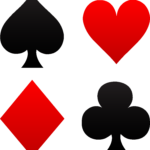The Meaning of Card Suit Symbols in Logos
- Their exact origin is hard to trace, though it is generally accepted that cards moved from the East to the West, with evidence of their use in China as early as the 9th century.
- With such a rich and diverse history, it’s crucial to remember that the symbols on cards are not quite universal.
- They have changed and adapted over time as a cultural indicator.
- The face cards have changed according to the society in which they printed.
- Interpretations of Card Suits Caption: A 1930’s deck of cards from Hungary.
- The suits of cards, indicated by ‘pips’, are the symbols that most of us know as hearts, clubs, diamonds and spades.
- As mentioned, the pips changed according to culture and context, but one theory says that the standard suits on European decks represented the hierarchies of medieval society, with clubs (then batons) representing peasants up to hearts for the clergy.
- Again, this has not been rigid.
- Diamonds may have been the top tier in French society, whereas spades are often the highest suit.
- However, there are several other symbolic associations of the suits of cards.
- These will be more useful to companies and logo designers, who can draw on whichever interpretation fits their model and ethos.
- – This one is a similar interpretation.
- – This one is a mystical interpretation, which associates suits with elements.
- Characteristics – Suits have specific characteristics and personality traits.
- Hearts are for the home, love, emotions and vulnerability.
- Clubs are for education and intellectual musing.
- Diamonds are for career, security, responsibility and judgment.
- The British even swapped the value of the king and queen according to who was in power while the Germans removed the queen completely and invented the jack.
- To this day, the ace is a prestigious symbol.
- Other face cards are not used as much in logos.











Leave a Review